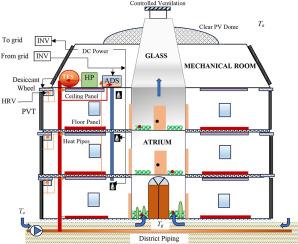Optimum utilization of power plant waste heat by nearly-zero exergy district prosumers for minimum carbon footprint
IF 5
Q2 ENERGY & FUELS
引用次数: 0
Abstract
This paper presents a new exergy-based model for minimizing the total carbon dioxide emission responsibility of district heating systems connected to thermal power plants. An optimal exergy balance can be determined between the degree of low-exergy prosuming buildings on the demand side and the utilization rate of waste heat from a power plant on the supply side. Therefore, the optimum degree of prosuming buildings and the utilization of waste heat in a district also minimize the embodied emissions and costs of prosuming buildings for sustainable growth. Following the massive earthquake in 2023 in the Afşin-Elbistan province located in the Southeast region of Türkiye, 10,000 apartments to be heated by individual boilers are compared with an alternative design using this model. This alternative design features low-exergy prosumer buildings integrated with the waste heat of the 1,355 GW lignite power plant. The waste heat is obtained from the nearby return pipe of the water-cooling system, which is connected to a river head, located 30 km away. The model played a crucial role in determining the optimal degree of low-exergy building design, which simultaneously minimizes the carbon footprint of the power plant and the embodied emissions of such buildings, thereby facilitating the optimal level of renewable energy sources for prosumption. A new exergy star green metric is introduced, with a maximum rating of five stars. The new model assigned an optimal of three stars for the alternative design, which minimizes the carbon footprint by reducing carbon dioxide emissions by 79 %.

电厂废热的最佳利用几乎为零的火用区产消者为最小的碳足迹
本文提出了一种新的基于火用的模型,用于最小化与火电厂连接的区域供热系统的二氧化碳总排放责任。需求侧低用能建筑的程度与供给侧电厂余热的利用率之间可以确定最优的用能平衡。因此,一个地区的最佳产建筑程度和余热利用也将使产建筑的隐含排放量和成本最小化,以实现可持续增长。在2023年位于 rkiye东南部地区的af in- elbistan省发生大地震之后,使用该模型将10,000套公寓与单独锅炉供暖的替代设计进行了比较。这种替代设计的特点是低能耗的产消建筑与1355吉瓦褐煤发电厂的废热相结合。余热从附近的水冷系统回水管中获得,该回水管连接到30公里外的河头。该模型在确定低能耗建筑设计的最优程度上发挥了至关重要的作用,使电厂的碳足迹和低能耗建筑的隐含排放同时最小化,从而促进可再生能源的最优消费水平。引入了一种新的能源星绿色指标,最高评级为5颗星。新模型为备选设计分配了最优的三颗星,通过减少79%的二氧化碳排放,将碳足迹降至最低。
本文章由计算机程序翻译,如有差异,请以英文原文为准。
求助全文
约1分钟内获得全文
求助全文

 求助内容:
求助内容: 应助结果提醒方式:
应助结果提醒方式:


